Northern India
I travelled in India in 2000 as a celebration of new places for the new millenium. Though I was there for three months I never made it beyond northwestern India because the diversity of the landscape and cultures was a constant source of amazement.
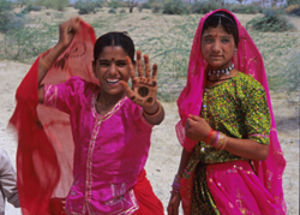
Rajasthan – brilliance in the desert
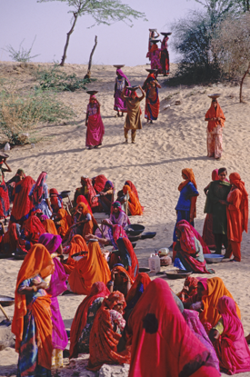
We had last seen the women as we drove to Jaisalmer, a hilltop fortress in the middle of the desert that sat close enough to the Pakistan border that people were always nervous. Three days later the same procession continued – a group of brightly sari’d women bearing shallow bowls on their heads followed a path up a small incline.
There were so many of them I yelled at my driver to stop and he did and I got out with my camera into the parched air, and leaden sunlight so brilliant I had to squint in my sunglasses.
As we approached, we were stopped by a group of young men who at first said ‘no photo’, but then relented when we took shots of them and promised to send them copies. Of course they provided no address to send to, but they allowed us past.
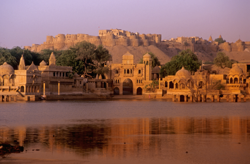
The women worked in a shallow basin of land filling their bowls with sand and then, balancing the bowls on their heads, took them up the hill to dump the dirt into a pile there. Apparently they were digging a well, but the area they were digging only had about 1 foot removed and the water was apparently 7 meters down.
Still, they dug and we snapped some pictures – much to the women’s disgust. Finally, I went down to them and the women crowded around me touching my hennaed hands, my camera vest, my hair. They were fascinated by my small gold earrings that were shaped like small golden balls. The women were beautiful in their bright saris, elaborate nose rings and lovely simple earrings, but they wouldn’t allow any photos. Too shy, I think, but I also think they would have relented except that the village headman came by and yelled at us to leave.
I guess we disturbed his project. I wonder, though, how many children went uncared for with all the women working. And where were the men?
Aside from the slackers who’d reclined in the shade of a palm tree until we arrived, I’d seen no men around.
Afterwards, I was told that the reason the women were so fascinated with my earrings was that their shape is the symbol of the‘children of the sun’ – one of the old royal families. It is a symbol usually worn by men. How odd it must have been for those women to see such a symbol born by a foreign woman.
April 2000
Saturday Sunrise in th Holy City of Varanasi
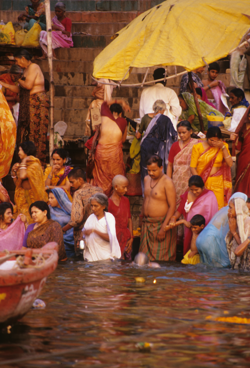
The sun rose red above the trees through mist over the northeastern bend in the Ganges River. When it leapt free of the winding mists it sent amber, early morning light onto the Ganges ghats (entryways down to the water) of Varanasi. The air and the river spray were cool as we traveled southward.
In this cool, the tourist boats floated southward around us and ferrymen took people to the ghats to bathe. A good Hindu should bathe in the river at least once in their life before entering the river on their final journey. On the river, fishermen tossed pale, green nets or ran green lines into smooth water between the remains of bodies. Around them pigeons settled onto logs, silhouetted in the sunlight and on the far side of the river, dog packs worried the human remains that had caught along the shore.
On our side of the river, at Main ghat, people came to the river to do laundry, wash dishes and to bathe for their salvation. The steps to the river teemed with people talking, laughing, living and praying. On the lowest steps, old women crouched over flames and small brass pots that they used to gather Ganges water. Men stood up to their waists in the filthy river to bathe and pray.
Farther south, past the Tiger House that was home to untouchables who earned the mansion by burning the corpse of a family member of the Maharaja, past the Temple of Small Pox, past mansions owned by the Maharaja of Jaipur, of Patna, of Udaipur pilgrims gathered from southern India. At the burning ghat of Harishehade, a lone corpse waited for burning, draped in gold. A man in white piled wood while an old woman rousted a dog from the ashes.
And still we traveled south into the folds of the water’s edge and the people’s eyes. I wondered if I looked into their eyes if I would have Darshan – a knowing descibed by the ancient Zoroastrian religion – and commune with them as a person or a god. It was hard to separate myself from these people when you could reach out to take their cool damp hands in yours or feel the Ganga water in your palm.
Walking home I met a woman in a white sari struggling with the folds of cloth in the wind. It kept tugging away from her and we both stopped on stairs and looked at one another and burst out laughing. Perhaps that is Darshan.
May 2000
Spiti – Along the Indo-Chinese Border
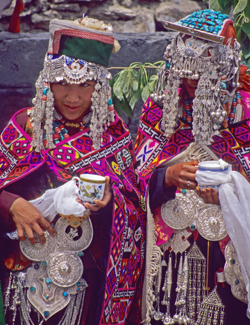
Outside the rattle-trap, bone jarring bus, the river ran down the deep Himalayan river valley past plated stands of poplar, while from the peaks came wind that carried sand so thick it looked like the mountains were smoldering. The sun on the Himalayas was brilliant and the air was thin and dry in my nostrils. The sound of wind was omnipresent.
At the village of Hurling, the wretched bus picked up a woman who had been injured by a falling rock. She was carried down the mountain by two family members and whimpered in the back of the bus. How she survived the jolting trip, I don’t know. The bus struggled through the dust and bounced across the landscape with the poor woman moaning. I finally offered her a pain killer I carry for my back. With trepidation she accepted and the moaning subsided a little.
At Tabo we stayed in an outbuilding of a thousand year old Tibetan Monastery. At 5 am we were up to the Monastery gongs that reverberated through your bones. The place was aflutter because of a visiting Tulku – a reincarnated Lama’s – visit to town. The monastery which once only had four monks before the Dalai Lama encouraged the development of Tabo, came alive with young, russet-robed monks, and women readying small, brass, egg-holder-shaped, butter lamps with poured ghee (melted butter)and specially shaped wicks. The quiet hum of their chanting filled the sun-drenched, mud-daub courtyard. Inside the temple sanctuary, women circled the prayer wheels working their prayer beads and murmuring ‘om mane padme hom’. The burning ghee lamps placed gutting golden light on their faces and the air tasted of butter.
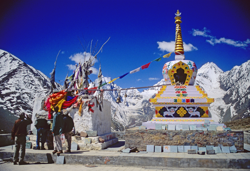
Later, everyone was dressed in their finery. Against the chill wind women wore pashmina scarves with brilliant colors banding each end. Girls wore their family’s wealth of silver and coral and turquoise in ornate headdresses and necklaces. Men wore long, Tibetan coats and furred hats backed with vibrant silk brocade.
The people lined the roadside waiting for the Tulku, but when he arrived he drove through the crowd and into the Monastery. Not even a sign to all these people who had worked and waited all day, now holding their offerings of yoghurt. When he came back he spoke for all of five minutes, struck out at two attempts to bat at a cricket ball, and then leapt to his car and left for other monasteries deeper in the mountains.
Unsatisfactory to say the least, and I wondered whether the people received the blessing they wanted, or whether Buddhism had just become a business there in the Indian Diaspora.
But regardless of the Tulku’s treatment, there was something in this landscape. Perhaps it was the people, or perhaps it was the mani stones, carved with those holy words ‘Om Mani Padme Hom’ that stood in cairns amid the miniature purple irises that abounded in the landscape. Perhaps it was the wind picking up those words, those calls sent forth in the vibrating prayer flags. Om Mani Padme Hom: meaning the transformation of the impure to the pure. Perhaps that was what made the woman with the injured leg and all these others strong enough to live their lives
May 2000









